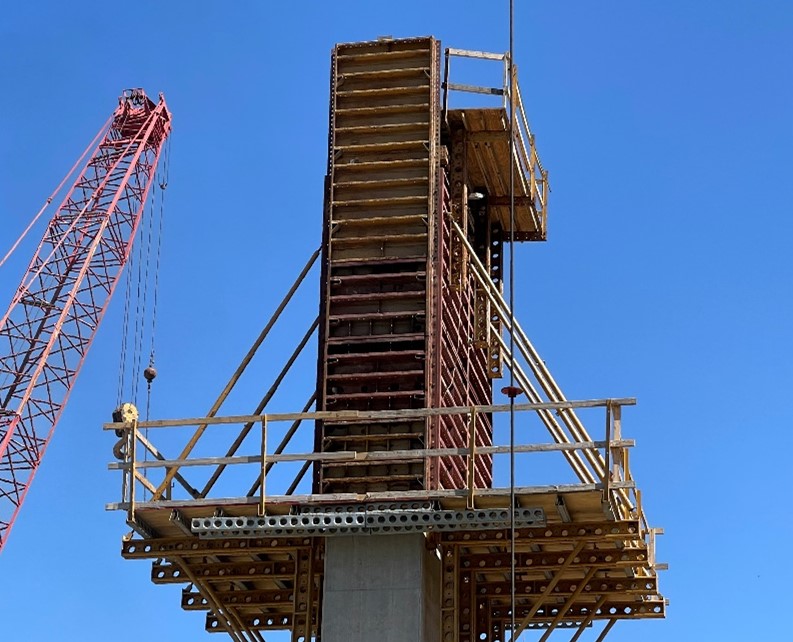In our continuing effort to introduce you to some of the safe working practices used at Haydon Bridge, we now focus our attention on fall protection. In the bridge industry, proper fall protection is of the utmost importance. In this blog, we’ll help you understand what proper fall protection is, define the basic rule of fall protection and explain how we protect workers from falling at Haydon Bridge.
The Fall Protection Rule:
The Occupational Safety and Health Administration (OSHA) defines our duty to have fall protection in the Code of Federal Regulation (CFR). Specifically, 29 CFR 1926.501(b)(1) mandates the following foundational rule of fall protection:
Each employee on a walking/working surface with an unprotected side or edge which is 6 feet or more above a lower level shall be protected from falling by the use of guardrail systems, safety net systems, or personal fall arrest systems.
This means, any time we are more than 6 feet off the ground or 6 feet above the next lowest level, we must use guardrails, safety nets or a personal fall arrest system. Notice, the above statement doesn’t give much room for interpretation nor does it give any indication about how far a person is from a potential fall area. So, whether you are standing 1 foot, 10 feet or even 40 feet from the fall hazard, you need to be protected from falling by one of the systems mentioned.
Guardrail Systems vs Personal Fall Arrest Systems
At Haydon Bridge, guardrails and personal fall arrest systems work best and that is what we’ll focus on here.
Guardrails
When constructed properly, guardrail systems will prevent someone from reaching the fall hazard. Think about some of the common things you encounter in life; railings around backyard decks/patios, railings or walls in parking garages or stairwells. All of these are guardrails used to prevent you from falling over the edge of those surfaces.
For guardrails to satisfy the fall protection requirement in construction, they must be installed correctly, meet certain height requirements, be capable of withstanding certain loads, and be constructed along the entire edge of the fall hazard OR entirely around a specific fall hazard. No gaps are allowed and the guardrails must be maintained properly as long as they are in place.

To help visualize the basic requirements of guardrails, imagine you are standing on a basketball court at center court and the entire basketball floor is elevated 20 feet in the air. To satisfy the OSHA regulation with guardrails, you would need to construct a guardrail system around the entire perimeter of the basketball floor. You cannot have any gaps and you must maintain the guardrail for the duration of your project. The same principle applies to a bridge under construction. Sounds simple, right? It is……sometimes.

When we can, guardrails are installed on the ground and lifted into place. Completing work on the ground is the safest and most efficient way, however, this cannot always be done. What about the areas and structures that must be built in the air? How do you put a guardrail around something that hasn’t been built yet?
Personal Fall Arrest Systems (Lifelines)
Where guardrails cannot be installed, we will use Personal Fall Arrest Systems or ‘Lifelines’. Unlike guardrails that PREVENT you from falling, fall arrest systems are intended to stop or ‘arrest’ your fall AFTER you have fallen.
For fall arrest systems to be considered proper, they must be engineered or designed for this purpose, the anchor points you connect to must be capable of supporting 5,000 lbs per employee attached, and many more requirements. Again, our intention is not to reproduce the OSHA manual but to simply introduce you to this subject.
Personal fall arrest systems are comprised of multiple components, including:
- Anchor points – must be capable of supporting not less than 5,000 lbs of force per person
- Lanyards or Retracting Lifelines – the cables that connect the person to the anchor points
- Harness – worn by the worker, the lanyard attaches to the harness
Now, let’s go back to our imaginary floating basketball court or, in our case, the bridge super-structure. As we progress with the construction of the bridge deck we must protect our workers from falls along the entire leading edge of the work area. To do this, we install fall arrest systems along the way. These systems include anchored posts with lifeline cables stretching the entire length of the bridge. Our employees connect to the lifeline cables while completing their work. Below, you can see a typical lifeline system used by Haydon Bridge.

Eventually, after the bridge deck has been enclosed with guardrails completely around it, the lifelines are removed from the bridge beams and returned to our shop.
Inspecting what we Expect:
Depending on the size, bridge projects may take months or even years to complete. Guardrail systems may be taken apart, reconstructed or sometimes left in place for lengthy periods of time. For this reason, we routinely inspect fall protection items many times over the life of a project. Inspections are documented, any deficiencies discussed with work crews and then corrected or repaired immediately.
Similarly, all lifeline systems will be inspected upon installation and individual components inspected again when returned to the home office in Springfield. Defective lifeline components are replaced if they cannot be repaired to original specifications.
Conclusion:
Haydon Bridge takes jobsite and employee safety very seriously! Our employees are our #1 asset and we will do what it takes to ensure they are safe while on our jobsites. Proper guardrails and fall arrest systems are important in our industry but employee safety doesn’t stop there. We will continue to introduce you to different areas of our work in the months ahead.
If you are interested in learning more about Haydon Bridge or want to become a member of our team, please peruse our website: www.haydonbridgecompany.com.







